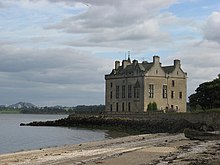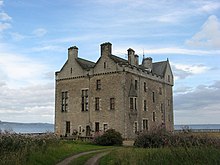Barnbougle Castle
Barnbougle Castle is a later heavily modified residential tower on the south bank of the Firth of Forth between Cramond and Queensferry in the Scottish Council Area Edinburgh . The tower is on the Earl of Rosebery's lands , just northwest of Dalmeny House . The tower's history dates back to the 13th century, but the current castle wasn't built until 1881 for Archibald Primrose, 5th Earl of Rosebery , who was Prime Minister from 1894–1895.
Origin of name
Older forms of "Barnbougle" are Barnbughall , Barbogle , Parnbogalle and Pronbugele . This name is derived from British tonic Brinn bugel (dt .: sheep shirt Hill), bar at bugel (dt .: top of the hill sheep shirt) or pren bugel derived (dt .: sheep shirt tree). All of these names presumably refer to the elevation just off the coast, which in fact provides an excellent view of the pastures around the Cockle Burn Estuary .
history
Barnbougle Castle belonged to the Mowbrays , a Norman family who were also Lords of Dalmeny and Inverkeithing . The first building was a residential tower that Philip Mowbray had built in the 13th century. In 1615 the Mowbrays sold Barnbougle Castle to Sir Thomas Hamilton , later the Earl of Haddington . His grandson sold the property on to Archibald Primrose, Lord Carrington , an elderly judge who was appointed Lord Justice General of Scotland in 1676 . Sir Archibald's eldest son by his second marriage, also Archibald , was named Earl of Rosebery in 1703 and Barnbougle Castle became his family seat. At some point during the 17th century, the old residential tower was torn down and replaced by a new building.
In 1774 the architect Robert Adam drew a plan for the new castle. He proposed a triangular building that contained the original residential tower as a seaward-facing corner. However, this plan never came to fruition. At the beginning of the 19th century the castle fell into disrepair and apparently a wave even hit the dining room during dinner. The 4th Earl of Rosebery had Dalmeny House built on his property and his family moved there after completion in 1817. Barnbougle Castle then served as a warehouse for explosives and was left as a ruin after it was damaged in an explosion.
In 1881 the castle was completely redesigned by the company Wardrop & Reid according to plans by James Maitland Wardrop and rebuilt in the Scottish Baronial Style. The older masonry on the north side was integrated into the new building. The building was created primarily to house the library of the 5th Earl of Rosebery (1847–1929), who became Prime Minister in 1894. Lord Rosebery practiced his speeches here in a specially built gallery hall. Barnbougle Castle remained part of Dalmeny House's estate and is still owned by the Earls of Rosebery today.
Historic Scotland has listed Barnbougle Castle as a Category A Historic Building.
description
The castle lies on a protruding rock terrace. It partly contains masonry from the old residential tower, but is mainly a building from the end of the 19th century. It has three full floors and an attic; The building material is quarry stone, which was clad with sandstone - ashlar .
Architectural details are stepped gables , crowd watch towers with gargoyles at the two western corners and a crenellated parapet . A 2.4 meter high obelisk sundial stands in the castle garden. It was installed there in 1890.
Say
According to legend, Sir Roger Mowbray went on a crusade to the Holy Land and died in a battle against the Saracens . His loyal hunting dog, who had stayed behind at Barnbougle Castle, began to howl uncontrollably at that moment. Eventually he died in mourning for his master. It is said that his whine can still be heard today at Hound Point , half a mile west of the castle, on dark, windy nights. In another version of the legend it is said that if the death of one of the lords of the castle were imminent, a black man with a dog would appear at this point and blow the baron's death melody on a horn . One ballad reads:
- And ever when Barnbougle's lords
- Are parting this scene below
- Come hound and ghost to this haunted coast
- With death notes winding slow.
Individual evidence
- ^ Bethany Fox: The P-Celtic Place-Names of North-East England and South-East Scotland in The Heroic Age . 10/2007. ( Appendix ). Retrieved February 24, 2017.
- ↑ Stuart Harris: The Place Names of Edinburgh: their Origins and History . Steve Savage Publishers, London and Edinburgh 2002. ISBN 1-904246-06-0 .
- ↑ a b c d Listed Building - Entry . In: Historic Scotland .
- ^ A b Edinburgh, Barnbougle Castle . In: Canmore . Royal Commission on the Ancient and Historical Monuments of Scotland. Retrieved February 24, 2017.
- ^ Shore Walk . Dalmeny Estate. Archived from the original on February 6, 2010. Info: The archive link was inserted automatically and has not yet been checked. Please check the original and archive link according to the instructions and then remove this notice. Retrieved October 7, 2009.
- ↑ Edinburgh, Barnbougle Castle, Sundial . In: Canmore . Royal Commission on the Ancient and Historical Monuments of Scotland. Retrieved February 24, 2017.
- ↑ Barnbougle Castle . In: Ancient Lothians . Archived from the original on August 19, 2010. Retrieved October 7, 2009.
Web links
Coordinates: 55 ° 59 ′ 32.8 " N , 3 ° 20 ′ 3.4" W.

